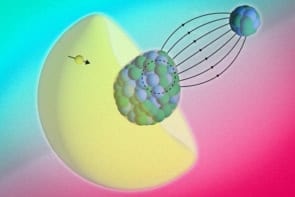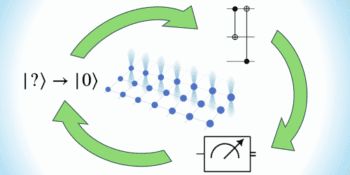It has long been known that when two different kinds of atoms clump together, some of the resulting clusters are more stable than others. Physicists in the US and Germany have now devised a rule that predicts the ratios of aluminium and hydrogen atoms that will form such stable clusters. They also say that the clusters could be packed together to form a new type of material that can store hydrogen for use as an energy source (Phys. Rev. Lett. 98 256802).

Atomic clusters are formed when a finite number of atoms clump together to form an ensemble larger than a typical molecule, but too small to be considered a bulk solid. Although any number of atoms can form a cluster, those with a certain ratio of elements, called “magic clusters”, are inherently more stable than others.
Magic clusters are interesting because they can be used as building blocks for new materials, the properties of which can be fine-tuned by adjusting the clusters’ composition. But no-one has ever been able to predict the magic ratios, which have previously had to be determined by trial and error.
Now a group led by Kiran Boggavarapu of Virginia Commonwealth University in the US has come up with such a rule by considering how clusters of two particular atoms – aluminium and hydrogen – bond together.
Just like molecules, clusters have a series of discrete energy levels, and only become stable once one of these is completely filled with electrons. Faced with a cluster of aluminium atoms, therefore, a hydrogen atom will bond in such a way to either take or donate an electron to fill a level. “It is so unusual that the smallest atom – hydrogen – can bring such a big difference,” Boggavarapu said.
For instance, if a cluster of aluminium atoms needs one more electron to become stable, a hydrogen atom could either form a “bridge” between two aluminium atoms or form a “cap” by linking three aluminium atoms. This would enable its electron to become delocalized so that it can be shared with the aluminium cluster. On the other hand, if a cluster has too many, a hydrogen could “radially” bond and withdraw the extra electron from the cluster. (See figure: “Like magic”.)
Using these electron-sharing conditions, the US group wrote an equation that predicted the different numbers of hydrogen atoms that could make a certain-sized cluster of aluminium atoms stable. A cluster of seven aluminium atoms, for example, could have either one radially-bonded hydrogen atom (Al7H), or it could have two radially-bonded hydrogen atoms and one bridge-bonded hydrogen atom (Al7H3).
Boggavarapu showed his group’s rule to Kit Bowen and co-workers at Johns Hopkins University to see if it worked for real magic clusters using a technique called photoelectron spectroscopy, in which ultraviolet light is used to knock electrons from a cluster so that their binding energy can be determined. They found that the binding energies for different magic clusters matched the bonding types that their rule predicted.
The researchers now want to see if the magic clusters will retain their properties when they interact together. If they do, they could be promising materials for storing hydrogen, which is widely touted as a clean alternative to fossil fuels as a source of energy. Boggavarapu told Physics Web that hydrogen is bonded weakly enough in aluminium-hydrogen magic clusters to allow it to be released at ambient temperatures and pressures.



